No products in the cart.

25 Myths and Misunderstandings about WCS
Reading Time: minutes remaining
I am simultaneously appalled and entertained by some of the things my students say in lessons. I don’t blame them for ignorance and I’m not disappointed in them in any way. But sometimes they report “facts” about the WCS scene that they have heard from their peers (and sometimes unfortunately from a teacher) that are beyond dubious – they’re freaking hysterical.
The tragic thing is that they wholeheartedly believe these myths, which have in effect been restricting or even derailing their dance progress and enjoyment.
There are loads of technical myths I could bring up, but those are best reserved for private lessons or in the Swing Literacy Teacher Development Program. Here I present instead a collection of not-so-technical myths, debunked.
1. You need a partner to take lessons with
This is a classic one you quickly figure out after your first few lessons. But this misconception is what prevents people from starting lessons in the first place. It happens because people assume when they read the ad for “partner dancing”, they interpret it as “dancing for partners only”; that having a partner is required in order to qualify. The idea of mixing partners is still foreign to people and needs to be explained: “No Partner Required”.
2. You should partner up as early as you can
This myth comes from regions that mostly offer workshops and events that regulate even balance of leaders and followers, so they encourage or require you to register with a buddy of the opposite role. But this does not mean you are married to that buddy, and have no claim on them. We teasingly encourage our students to be "poly-practicers": mixing and switching up their practice partners all the time so they develop adaptability skills and get more than one source of feedback.
3. All follower styling comes from hijacking
This gem came from a Novice student of Myles’ who, in her assessment dance, interrupted Myles’ lead constantly, added beats, and randomly changed her own direction in order to show off her “styling” for him. Her reasoning? She was told by her local teacher that in order to style, you have to stop following and steal the lead. She actually was trying to impress Myles with her hijacking.
Myles quickly set her straight, explaining that the follower can style any time, any where, any way they please, as long as it doesn’t disrupt the leader’s direction or the follower's ability to detect it. There is a whole world of styling out there for followers’ styling that has nothing to do with hijacking. Here’s my video series to prove it!
4. In order to express yourself you have to sacrifice your partner
An Advanced student told me that several of her peers advised her that in order to express herself in the dance, she should abandon the connection and do what she wants on her own, and that the leader needs to wait until she’s done.
This a grossly misinterpreted and incomplete story. Imagine if you applied this approach to a verbal conversation? You would soon run out of people willing to listen to you.
Follower styling evolves with your skill level: first you have to learn how to isolate your connection in order to “play” so that you don’t interrupt the leader’s flow. But as you become more Advanced, there are more complex connection techniques to learn that enable you to play in ways that not only involve your partner, but also contribute to and augment the conversation.
Bottom line? Never throw your partner under the bus just for your own agenda. Advanced connection skills are the key to getting more playtime.
5. Shaping/bodystyling is only for young dancers. For mature dancers, It is only appropriate to do square footwork.
There are many mature role models who were Champions in an era that valued footwork, and before body shaping and slot shaping became popular. But this doesn’t mean that mature dancers are restricted to just copying them. All styling is available to all dancers, as their fitness permits. I made the “Got Play” followers' styling video series explicitly for this purpose.
6. West Coast Swing came from Modern Jive
Modern Jive is a far-removed decendant of Lindy Hop. West Coast Swing is a direct descendant from another line. Modern Jive emerged long after West Coast Swing, and while the basic bares little resemblance, the preferred stylings of Modern Jive continue to borrow from West Coast Swing's techniques and trends. Get a relatively thorough crash course in WCS History here, but we provide a much more thorough version within the Swing Literacy Dancer Development Program.
7. West Coast Swing started in the early 2000s.
West Coast Swing evolved from Lindy Hop in the late 50s, and continues to evolve and reinvent itself each decade. Teachers in your area might have discovered it for themselves in the early 2000’s, but WCS history predates them by half a century.
8. To survive your first social dance party, you have to be very competent if not perfect.
When you speak to a foreign person who is learning your language, do you expect perfect accent and grammar from them? Of course not. If dance parties were restricted to only people who were nearly flawless, it would be a lonely night. No one expects you to know it all in the beginning, or ever!
Learning is messy and glorious. Your partners will be a lot more forgiving than you think. if you come across a sourpuss who is not forgiving, just brush them off as you would any other rude person at a dinner party, and go enjoy yourself with everyone else.
9. A good social dance is one where I make little to no mistakes.
I have a distinct memory of being obsessed with this in the early stages of my dance development. The problem is, I was very rarely satisfied, and often ended the night angry with myself because of all the mistakes I was tallying. That’s no fun! Then after a few teachers set me straight, I realized that was about as silly as gauging the quality of a phone conversation by how many grammatically perfect sentences I spoke.
Improv dancing is as casual, flexible, spontaneous and unpredictable as conversations. Mistakes mean nothing – they are happy accidents that offer unexpected outcomes like plot twists.
10. Social dancing = Competition practice
This is common in competitive ballroom culture: social dance parties are just open practice times where couples pair off and practice their competition choreography. Some dancers and even some regions have missed this concept and are treating their social dance parties as open practice times. This leads to isolation, levelism, and degradation of the community, and dancers fall behind in their development of improvisation and adaptability.
I’m not saying that it’s not cool to practice some elements during social dancing, but take into consideration their appropriateness for your partner’s level, involvement, the song, and the environment.
11. Private lessons are only for advanced/serious dancers. I need to wait till I’m a better dancer before I can take lessons from a better teacher.
When you want to get in shape, you hire a personal trainer. Every fitness centre has personal trainers that are available to the average joes, not just bodybuilders. Private dance lessons are the same. There is no such thing as a minimum level requirement. You want to learn fast, properly, and get the most for your money? Nothing beats one-on-one. For the full story of this myth, check out the article “It’s Not Like Wine”.

12. Competitions and routines are only for advanced dancers.
Actually, like Karate, there are competition divisions for every stage of your development, from newbies to teachers. But improvised and choreographed competitions are neither a required nor expected element: social dancing is the primary goal of WCS. There are pros and cons to competition that should be weighed to decide if it’s right for you. Like horse riding, you can enjoy the activity without any ambition for competitive racing or dressage. Curious about doing a routine but not sure if you’re ready? Check out this article, or this one about Rising Star division
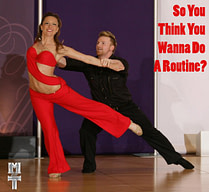
13. You should only social dance with people at your own level
Unfortunately, this is a carryover from dance schools of other styles that dictate you should only perform moves that are part of your level’s Syllabus, and dance with peers at your level. There's also a myth that your skills will be "tainted" by dancing with lower level partner who have bad habits. In fact, the opposite is true: you will build more resilience and adaptability by dancing with them.
Not only is "dancing in your lane" counterproductive to building a dance community, but it encourages levelism and hinders your adaptability skills. For your own development and social citizenship, feel free to social dance WCS with the widest variety of partners possible.
14. Older dancers are weaker and not as fun to dance with
What do you think happens to past Champions when they age up? It’s not like they “turn boring”! Why not apply this assumption to the average dancer too?
Age is not a reliable indication of competence. Great dancers get better with age. Young dancers still have much to learn. Consider that a dance with a Masters-aged dancer will offer you a different experience than the young, bendy 20-year old, but that difference is something to be revered and sought after. Some of those older dancers you might dismiss are actually diamonds in disguise. Once dance with them can teach you more about your own dance than a handful of private lessons. Often, I enjoy dancing with a grandfatherly leader who has taken the time to learn what the followers like, and is more generous to his followers instead of selfish and oblivious.
15. Never ask a more advanced dancer to dance- wait till they ask you.
I subscribed to this myth when I first entered the dance scene too. As a newbie dancer, nobody told me this explicitly, I made the rule up on my own. Of course I later realized my error and mourned my opportunities wasted. There are no social rules dictating who should invite whom to dance- it is completely unrestricted. So go ahead and ask whomever you choose, just pace yourself and don’t be a stalker.
16. Pros owe you a social dance
There is alot of controversy about the topic of pros being willing to social dance. Regardless of their reasoning to or not to dance with you or at all, they do not owe you a social dance. They are there to teach and entertain the total group of dancers in attendance, so they owe the masses their instruction and performance, but private attention is something that is paid for separately, such as in a Pro Am comp or a private lesson.
Social dancing at most events is optional, and encouraged, but not always required, and if it is required for a particular time period, there is no promise of each individual dancer receiving a dance with a pro. Pros are human, not machines, and their safety and well-being is their livelihood, which must be their first priority.
17. Everyone is allowed to do dips
Everyone deserves access to dip instruction. But if you have not been trained in how to stabilize yourself and support another human being who is relying on you for their safety, you do not automatically have permission to experiment with their body. It is also not safe to assume that every follower is healthy enough to to dips. Get trained. Ask for consent.
18. Partners owe you a technically good dance
Nobody owes you an amazing dance. You deserve safety and to be treated respectfully, but nobody “owes” you any type of dance. Assume that everyone is trying their best. No one is holding back their proper technique from you and “saving it” for their next partner. Everyone is at different stages of the learning game, so it is unrealistic and unfair to be disappointed. It is what it is.
Sometimes your partner doesn’t even know how to count to 6 yet, but you can still find ways to enjoy other aspects of WCS such as elasticity and musicality: just embrace it as a “WCS-ish” dance and practice your adaptation skills. Once you release yourself from the idea that anybody owes you an ideal WCS dance, you will find yourself more satisfied at the end of the night.
19. More patterns = more challenge = more fun
Try to think less like a gamer and more like an athlete and an artist. The fun of WCS does not come from how many coins you collect or bad guys you eliminate, but rather in how you manipulate physics to do your bidding. Patterns are simply the context – the containers for the juicy parts of our art. Don’t collect containers; collect content. Enjoy the challenge of pursuing mastery over your own body, your partnering, musicality, etc.
20. Contemporary music isn’t swing
Well, if you are referring to songs with a shuffle rhythm, you are mostly right. 98% of contemporary songs contain straight time or a latin rhythm that is not shuffle/swung timing. But, straight time is not a modern development: WCS adopted straight time songs decades ago in the form of Soul, Funk, and straight time Blues. Which means you don’t need shuffle rhythm to dance WCS. So while the DJ plays straight time contemporary songs, why not get up and dance and celebrate West Coast Swing’s evolution and flexibility? We train our students exactly how to adapt their dance to different genres inside of the Swing Literacy Dancer Development Program.
21. Blues music is old and boring
In any genre, there is good music and bad music. Don’t judge a genre based on your limited exposure if all you’ve ever heard played was bad. Some DJs don’t understand Blues music enough to select the songs that are good quality and good for WCS, so they just play Blues for Blues’ sake. The effect is that dancers draw the conclusion that Blues is old and boring. Why not think like a good DJ, do your research on how to identify a good WCS Blues song, and go hunting for more? We train our students exactly how to relate to, listen to, and appreciate good Blues music inside of the Swing Literacy Dancer Development Program.
22. Workshops are only for beginners
Here’s how it works: Labelled workshops indicate the level of material the instructors will address, not the level of dancer they expect to attend. Levelled workshops are restricted by an audition process to confirm that all dancers are accurately grouped according to skill level so that the workshop material can be targeted.
Workshops always contain great content you can use at every phase of your dancing. Smart Advanced dancers take beginner workshops because they know they didn’t absorb everything they needed the first time around and they care about becoming a complete dancer. Be a smart dancer. Check your ego. Never stop learning.
23. Great dancers must be good to learn from. The better the dancer, the better they can teach me to dance.
Dancing is a physical skill. Teaching is a mental skill. They are mutually exclusive. Sometimes, you get great dancers who also happen to be great teacher. But often you have great dancers who have fallen into the teaching pool and learn to swim out of necessity but aren’t particularly skilled. Great dancers have figured out how they can physically create the movements they want for themselves, but that doesn’t mean they understand how to teach someone else to create them.
24. Giving feedback to your partner is always helpful and welcome.
Feedback is a powerful tool – make sure you are using it for good and not evil. Here’s a powerful article to learn the art of it.
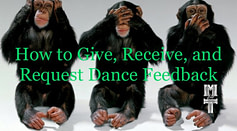
25. Your previous dance training will hinder your WCS progress. You need to forget all of it in order to learn WCS.
All dance training provides a benefit to your balance, coordination, control, body awareness, and musicality. No matter what dance style you learned before, there will be several elements that you can use that will make your WCS learning progress faster. There will also be missing elements you will need to catch up on, and elements that need to me modified in order to function in WCS. But don’t let anyone tell you that your dance background is anything but an asset. We train our students exactly how to convert and capitalize on their prior dance training inside of the Swing Literacy Dancer Development Program.
Can you think of any more? I would be happy to add to this list. Remember to focus on non-technical myths and misunderstandings.
You must be logged in to post a comment.
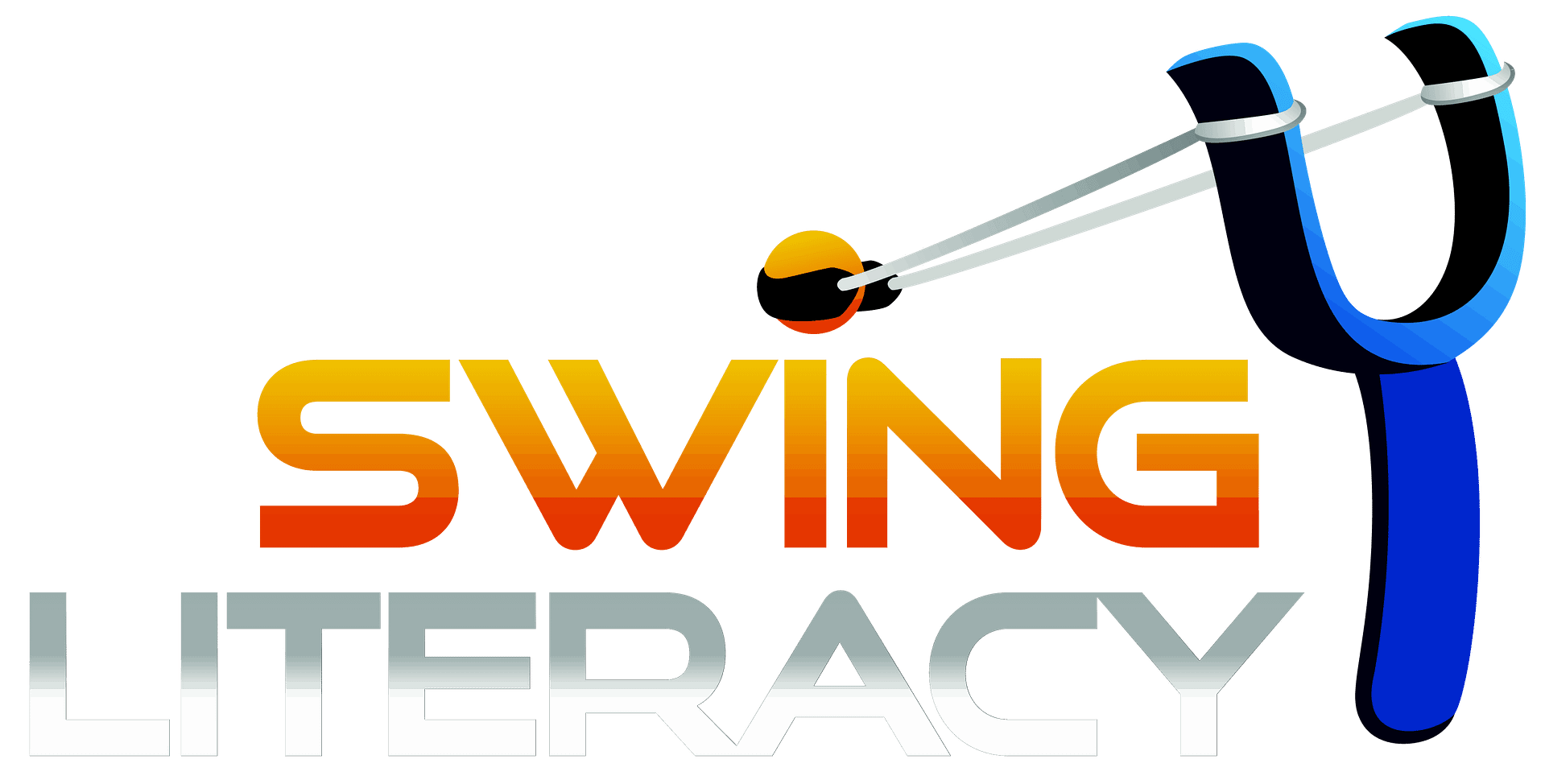
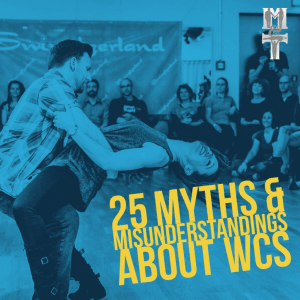 I am simultaneously appalled and entertained by some of the things my students say in lessons. I don’t blame them for ignorance and I’m not disappointed in them in any way. But sometimes they report “facts” about the WCS scene that they have heard from their peers (and sometimes unfortunately from a teacher) that are beyond dubious – they’re freaking hysterical. The tragic thing is that they wholehearted believe these myths, which have in effect been restricting or even derailing their dance progress and enjoyment. There are loads of technical myths I could bring up, but those are best reserved for private lessons or in the
I am simultaneously appalled and entertained by some of the things my students say in lessons. I don’t blame them for ignorance and I’m not disappointed in them in any way. But sometimes they report “facts” about the WCS scene that they have heard from their peers (and sometimes unfortunately from a teacher) that are beyond dubious – they’re freaking hysterical. The tragic thing is that they wholehearted believe these myths, which have in effect been restricting or even derailing their dance progress and enjoyment. There are loads of technical myths I could bring up, but those are best reserved for private lessons or in the  11. Private lessons are only for advanced/serious dancers. I need to wait till I’m a better dancer before I can take lessons from a better teacher.
11. Private lessons are only for advanced/serious dancers. I need to wait till I’m a better dancer before I can take lessons from a better teacher.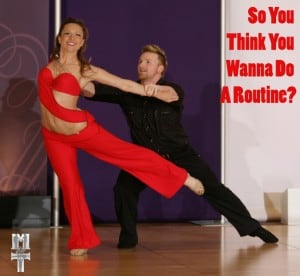 12. Competitions and routines are only for advanced dancers.
12. Competitions and routines are only for advanced dancers.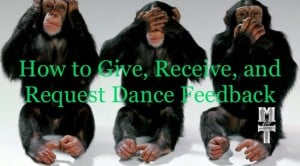 24. Giving feedback to your partner is always helpful and welcome.
24. Giving feedback to your partner is always helpful and welcome.
Fantastic article. Should be required reading. Thank you!
Great article! I say many of the same things to my students as well!????
THIS : Mistakes mean nothing – they are happy accidents that offer unexpected outcomes like plot twists.
Brilliant! 🙂
Thank you Tessa & Myles – terrific! Dancingly, Debbie
I feel I need to defend the newbies on your first point. It’s a fair assumption for a newbie that a partner is required when they’re not presented with contrary information. It’s entirely an organizer/advertising problem. Newbies make the best assumption they can based on the information they’re exposed while looking for opportunities to join some form of partner dancing. A newbie often will encounter other ads or find other groups that do, for various reasons require a partner. Ads and marketing material should always expressly state “no partner required”. We owe it to inform our newbies what our scene is about so they have informed perceptions. Attending an activity without a partner that sometimes requires one can be perceived as a risky proposition when we aren’t clear that people are welcome with or without a partner. The same can be said for non-traditional gender roles which are welcome in some dance scenes and not welcome in others.
I have another one…a bad dance is all your fault. I subscribed to this alot especially when I would dance “up”.. Sometimes I would think that a dance was bad or that a partner didn’t like dancing with me .but in reality they were tired, out of sorts or they didn’t like the floor or the song or we were just out of sync.. More often (unless you didn’t follow the WCS etiquette article) its circumstantial. Give it another try with that dancer to a different song or a different venue and you might find its a whole different experience.
The currency of your article can not be denied. These “myths” and their part in our dance education and dancing lives will tremble at the sight of more and more discussion. You present us with a good first couple of steps but I fear the persistence of these babies won’t go away with just one mention. Or even two, but at least we seem to be thinking about it. It’s a super ordinate goal I think.
Just because someone is older it does not mean they cant do all the bendy stuff. Many are in great shape. Give us a chance. Nothin’ beats that look on my young leader’s face when i dip or finger spin or show that i have the last moves down. (Hopefully w out overdoing it!)